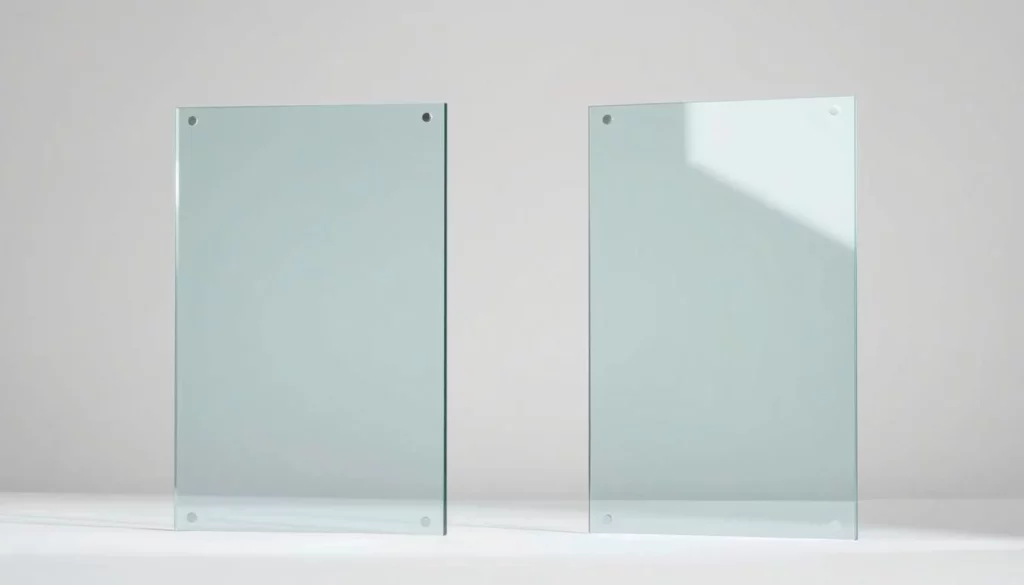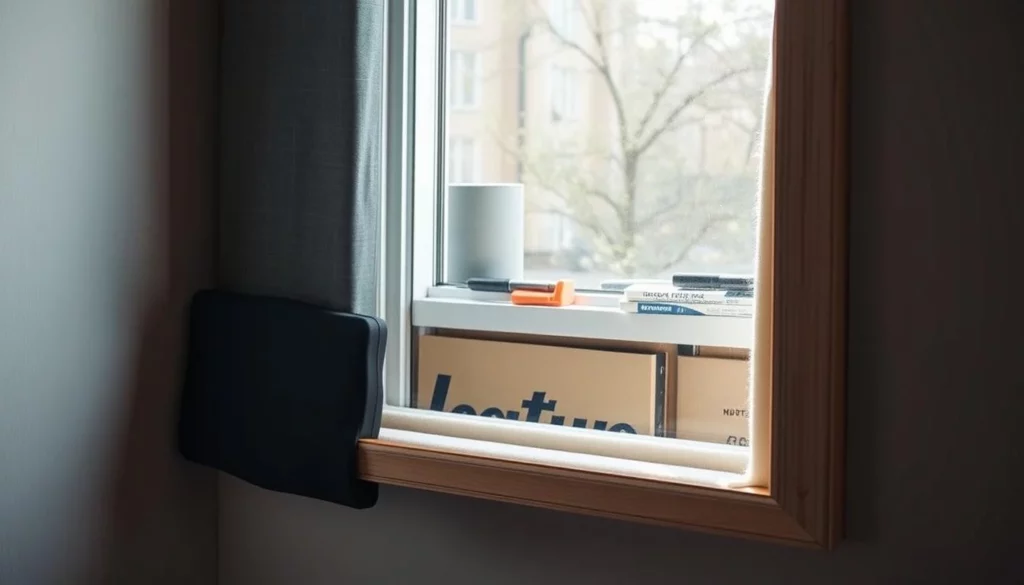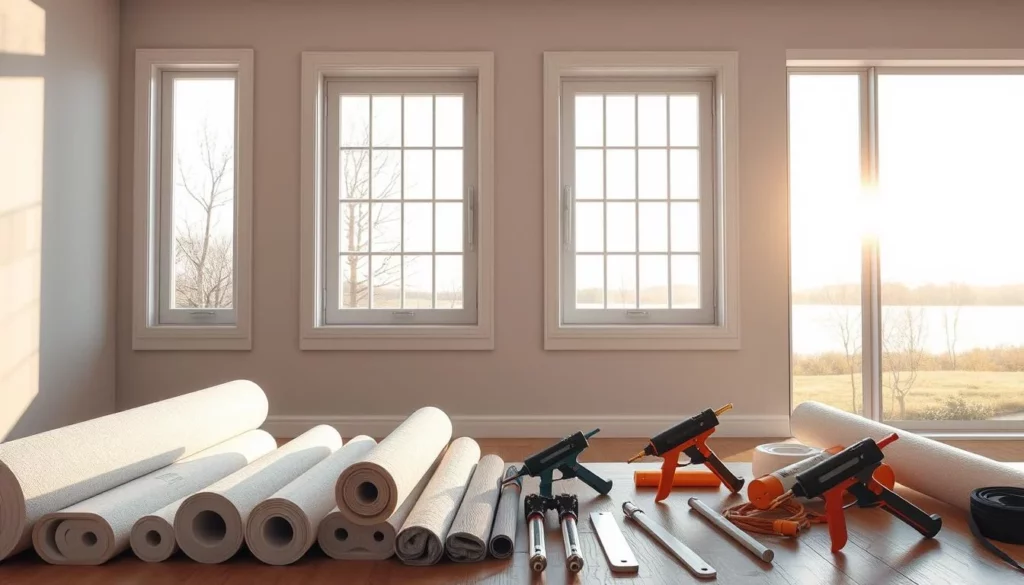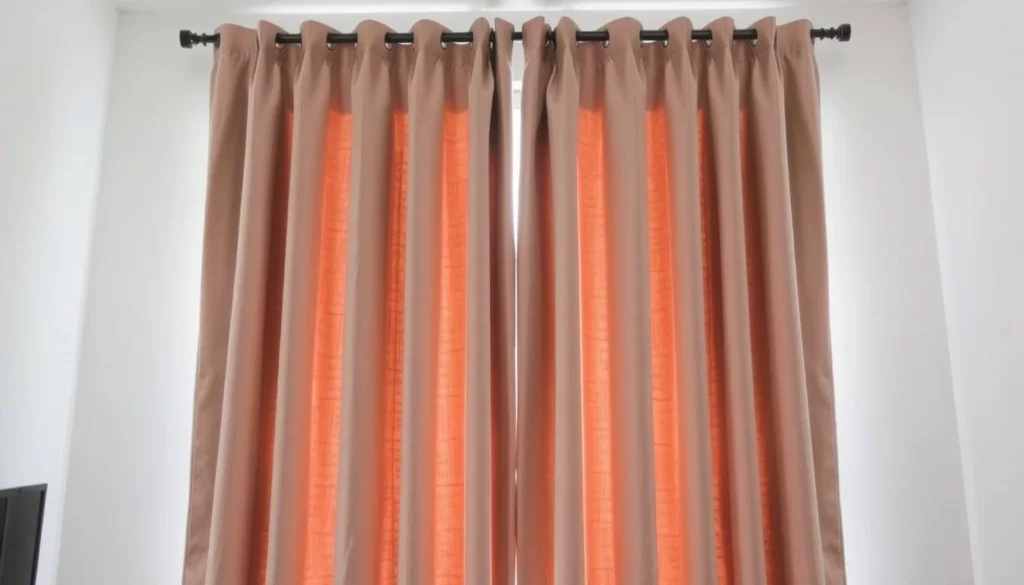Are you tired of constant noise in your life? Soundproofing can help reduce unwanted noise. It makes living or working spaces more comfortable.
The type of glass used is key in soundproofing. Laminated and tempered glass are two popular choices. They have different soundproofing abilities.
Recent studies show that laminated glass is better at sound. It has an interlayer that helps block noise. This article will explore the differences between laminated and tempered glass. It aims to help you choose the right one for your soundproofing needs.
Understanding Soundproofing Basics
Before picking between laminated and tempered glass for soundproofing, it’s key to grasp the basics. Soundproofing is vital for a comfy and productive space, whether at home or work.
What is Soundproofing?
Soundproofing stops sound from getting in or out of a space. It uses materials and methods to cut down noise, making the sound environment better. Good soundproofing boosts privacy and cuts down on distractions.
The Importance of Soundproofing in Your Space
Soundproofing keeps your space quiet, which is important in noisy areas. It helps you focus better and feel better overall. Plus, it can make your property more appealing to others who want a quiet place.
Choosing the right glass for soundproofing matters. Laminated and tempered glass each have special qualities for noise control. Knowing these differences helps you pick the best glass for noise reduction.
The Science Behind Soundproofing
Soundproofing isn’t just about stopping noise. It’s about understanding how sound moves and how materials like glass can stop it. To soundproof a space well, you must know how sound travels and how it interacts with different materials.
How Sound Travels
Sound moves in waves and can go through air, water, and solid things. When soundproofing, the main thing is how these waves hit building materials, like glass. The type of glass used can greatly affect how sound travels. For example, sound can make glass vibrate, and these vibrations can send sound into a room.
Types of Sound: Airborne vs. Impact Noise
There are two main kinds of noise in soundproofing: airborne and impact noise. Airborne noise is sounds that move through the air, like voices or music. Impact noise is made by touching a surface, like footsteps. Knowing the difference between these two types of noise is key for good soundproofing. Different materials and glass types work better against one type of noise than the other.
- Airborne noise can be lessened with materials that absorb or block sound waves.
- Impact noise needs materials that can dampen vibrations and lessen the sound they send.
By understanding how sound travels and the types of noise you’re up against, you can choose the best glass and soundproofing methods for your needs.
Introduction to Laminated Glass
Laminated glass is a top pick for soundproofing. It’s known for its special mix and how it works. But, what makes it so good at blocking out noise?
What is Laminated Glass?
Laminated glass is made by putting a plastic layer, usually polyvinyl butyral (PVB), between two glass sheets. This is done by heating and pressing the layers together. It makes a glass that’s both strong and lasting.
The way laminated glass is made makes it not just strong but also great at blocking sound. Its sound-reducing abilities make it perfect for cutting down on noise.
Benefits of Laminated Glass for Soundproofing
Laminated glass has many soundproofing perks. It’s great at soaking up and spreading out sound waves. This means less noise gets in or out of a room.
- Enhanced soundproofing capabilities
- Increased safety due to its durable construction
- UV protection from the PVB layer
| Feature | Description | Benefit |
|---|---|---|
| Soundproofing | Absorbs and dissipates sound waves | Reduces noise pollution |
| Safety | Ductile PVB layer holds glass together | Reduces risk of injury from shattered glass |
| UV Protection | PVB layer blocks UV radiation | Protects furnishings from fading |
Choosing laminated glass boosts your space’s soundproofing. It makes your area more comfy and quiet.
Introduction to Tempered Glass
Tempered glass is made strong and safe through a special heat treatment. It’s heated high and then cooled fast. This makes it stronger and more durable.
Manufacturing Process
First, the glass is cut to size. Then, it’s heated to about 600°C. Next, it’s cooled quickly with air jets.
This cooling makes the glass’s outer parts rigid. The inner part stays hot. As it cools, the outer parts contract, making the glass strong.
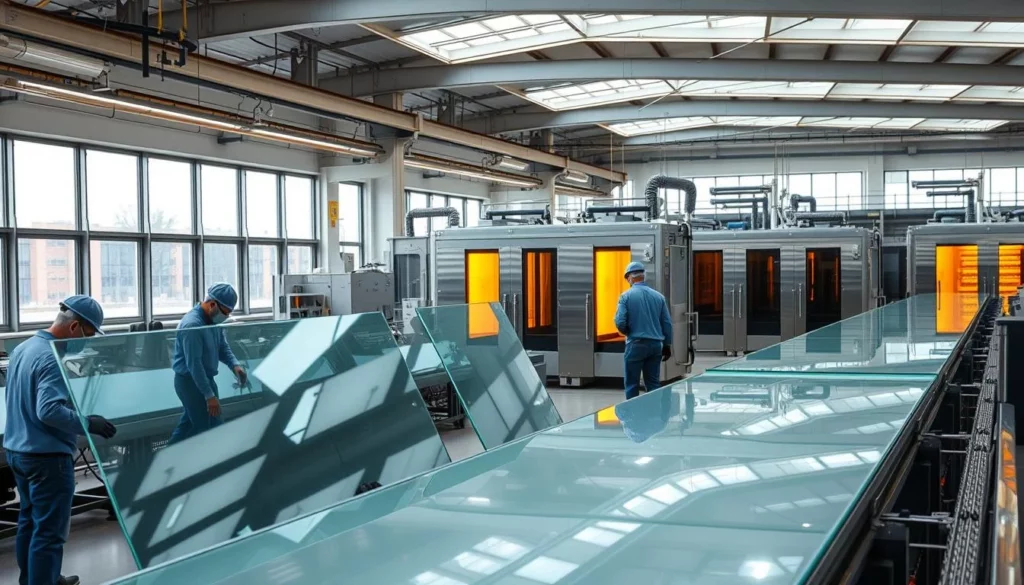
Benefits and Limitations for Soundproofing
Tempered glass is safe and durable. It breaks into small pieces, not sharp shards. But, it’s not great for soundproofing.
It’s strong against heat but doesn’t block sound well. The thickness and seal tightness matter more for soundproofing.
| Glass Type | Soundproofing Capability | Safety Features |
|---|---|---|
| Tempered Glass | Moderate | High |
| Laminated Glass | High | Moderate |
The table shows tempered glass is safe but not good for soundproofing. Laminated glass is better for sound but not as safe. Knowing this helps choose the right glass.
Comparing the Soundproofing Properties
Laminated and tempered glass have different soundproofing abilities. Knowing these differences helps you pick the right glass for your needs. When looking at laminated glass vs. tempered glass for soundproofing, it’s important to look at their Sound Transmission Class (STC) ratings. This rating shows how well they block noise.
Sound Transmission Class (STC) Ratings
The Sound Transmission Class (STC) rating shows how well materials block sound. A higher STC rating means better soundproofing. Laminated glass usually has a higher STC rating than tempered glass because of its special interlayer.
Laminated glass often gets an STC rating of 35-40. This depends on the interlayer’s type and thickness. On the other hand, tempered glass usually gets an STC rating of 28 to 32. The STC rating difference between laminated and tempered glass is key to soundproofing a space.
| Glass Type | STC Rating Range | Soundproofing Effectiveness |
|---|---|---|
| Laminated Glass | 35-40 | High |
| Tempered Glass | 28-32 | Moderate |
Overall Effectiveness in Reducing Noise
The STC rating of laminated and tempered glass shows how well they block noise. Laminated glass is generally more effective at blocking airborne noise. This is because of its layered construction, which absorbs and dampens sound waves. Tempered glass, while still good, is more likely to let sound through because it’s not layered after tempering.
When deciding between laminated and tempered glass for soundproofing, think about how much noise you need to block. For places needing a lot of soundproofing, like recording studios or home theaters, laminated glass is better. For areas needing less soundproofing, tempered glass might work well.
Installation Considerations
Proper installation is key to getting the most out of laminated and tempered glass for soundproofing. When picking glass for soundproofing, knowing how to install it is crucial. This ensures you get the best results.
Installing both laminated and tempered glass needs careful planning. It’s not just about the glass. You also need to think about the frame, sealing, and other materials used.
Common Installation Techniques for Laminated Glass
Laminated glass is great for soundproofing because of its special interlayer. To install it right, you can use a wet glazing system. This method uses a sealant to block air leaks and improve soundproofing.
Another way is the dry glazing system with gaskets. These gaskets create a tight seal around the glass. This helps keep sound in and outside sounds out.
The type of frame you choose is also important. A sturdy, heavy frame helps reduce vibrations that can affect soundproofing. It’s also crucial to support the laminated glass well and not damage the interlayer during installation.
Common Installation Techniques for Tempered Glass
Tempered glass isn’t as soundproof as laminated glass but can still work well if installed correctly. The installation for tempered glass is similar, focusing on a tight seal between the glass and the frame. But, tempered glass breaks into small pieces if it shatters, so it needs extra care.
For tempered glass, using a resilient channel or gasket system helps absorb vibrations. This prevents sound from leaking. It’s also important to pick a frame that fits tempered glass’s needs, like its thickness and the sealant used.
In summary, how you install glass greatly affects its soundproofing abilities. By picking the right installation method and materials, you can boost the soundproofing of both laminated and tempered glass.
Cost Analysis of Laminated vs. Tempered Glass
It’s important to know the cost differences between laminated and tempered glass for soundproofing. When choosing the best glass for noise reduction, think about the upfront cost and long-term savings. Also, consider the maintenance costs for each type.
Initial Costs vs. Long-Term Savings
Laminated glass costs more at first than tempered glass. But, it offers better soundproofing and lasts longer. This can save you money in the long run because you might not need extra soundproofing.
Tempered glass is cheaper at first but might not block sound as well. You might need to spend more on soundproofing later. So, compare the first costs with the long-term benefits when deciding.
Key Considerations:
- Laminated glass blocks sound better, which might save you money on extra soundproofing.
- Tempered glass is cheaper at first but could cost more later if you need more soundproofing.
Maintenance Costs Over Time
Maintenance is a big part of the cost difference between laminated and tempered glass. Laminated glass is more durable and can handle harsh conditions better. This means it costs less to maintain over time.
Tempered glass is strong but can get damaged more easily. It might break due to nickel sulfide inclusions or edge damage. This can make maintenance more expensive.
Maintenance Comparison:
| Glass Type | Initial Cost | Maintenance Cost | Long-Term Savings |
|---|---|---|---|
| Laminated Glass | Higher | Lower | Higher |
| Tempered Glass | Lower | Higher | Lower |
Think about both the first costs and the long-term effects, including maintenance. This will help you choose the right glass for your soundproofing needs.
Environmental Impact
Choosing between laminated and tempered glass for soundproofing means looking at their sustainability. Each type has its own production process, affecting their environmental impact.
Sustainability of Laminated Glass
Laminated glass is made by placing a PVB layer between two glass panes. Its production uses a lot of energy. But, its durability means it might not need to be replaced often, saving energy in the long run.
Some makers are using recycled glass in laminated glass. This makes it even more eco-friendly.
Sustainability of Tempered Glass
Tempered glass is made by heating and cooling it quickly to make it stronger. This process uses more energy than regular glass. Yet, tempered glass can be recycled fully.
Its strength means it lasts longer, possibly reducing waste. Some producers use recycled glass in tempered glass, lowering its environmental effect.
Both laminated and tempered glass have good and bad sides for the environment. Knowing these can help you choose what’s best for your eco-friendly goals.
Aesthetic Considerations
When you think about soundproofing, how the materials look is key. Both laminated and tempered glass can make your space look better while keeping it quiet. You can pick from many options, based on what you need and like.
Design Options with Laminated Glass
Laminated glass is very flexible in design. You can pick from many colors, patterns, and thicknesses. Laminated glass can be customized to fit any style, from modern to classic. It can also be mixed with other materials for a unique look.
Design Options with Tempered Glass
Tempered glass is strong and safe, and it looks good too. You can choose from clear, tinted, or frosted finishes. Tempered glass can be used for clean designs or fancy features like glass railings.
Choosing between laminated and tempered glass depends on your style. Think about your space’s look, how much light you want, and how you’ll use the glass. Both can make your space both beautiful and useful.
Knowing what design options laminated and tempered glass offer helps you choose. You can find a balance between looks and soundproofing.
Real-World Applications
Laminated and tempered glass have different uses in soundproofing. Knowing how they are used can help you decide what’s best for your needs.
Best Uses for Laminated Glass
Laminated glass is great for places where soundproofing matters a lot. This includes recording studios, home theaters, and homes near highways. It’s perfect for these spots because it blocks sound well.
- Recording studios and home theaters where sound quality is paramount.
- Residential buildings in noisy urban areas or near airports.
- Office spaces that require a quiet environment for concentration.
Laminated glass is also used in commercial building facades. It helps reduce outside noise, making the inside more comfortable.
Best Uses for Tempered Glass
Tempered glass is used where safety and durability are key, like in shower doors, glass railings, and car windshields. It doesn’t block sound as much as laminated glass, but it still cuts down noise a lot.
| Application | Laminated Glass | Tempered Glass |
|---|---|---|
| Recording Studios | Highly recommended for soundproofing | Not typically used due to lower soundproofing capability |
| Residential Buildings | Ideal for sound reduction | Suitable where safety is a concern |
| Commercial Buildings | Used for glass facades to reduce noise | Used for safety and durability |
When picking between laminated and tempered glass, think about what your project needs. Consider how much soundproofing you need, safety, and how it looks.
Making Your Choice for Soundproofing
Choosing between laminated and tempered glass for soundproofing involves several factors. Your budget, the specific application, and the sound reduction level you want are key. Knowing these will guide you to a decision that fits your needs.
Key Considerations
Your budget is a big factor. Laminated glass is more effective for soundproofing but might cost more than tempered glass. Yet, its sound reduction might be worth the extra cost. Tempered glass, on the other hand, balances cost and performance well.
Tips for Selection
First, think about your soundproofing needs. For reducing airborne noise, laminated glass is a good pick because of its sound-absorbing layer. If safety is a priority, tempered glass is a strong and shatter-resistant choice.
It’s wise to talk to a professional. They can help you pick the best glass for your situation. This ensures you get the sound reduction you need.
